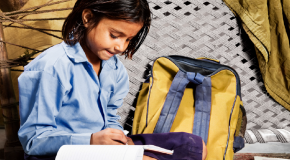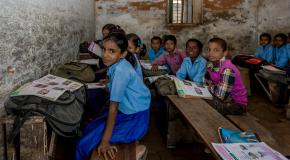This is the first in a series of case studies commissioned by UBS documenting charitable organisations. For more, see here.
One of India’s great economic advantages is the relative youth of its population. By 2020 it will become the world’s youngest country, with 64% of its people at working age. To make the most of this democratic dividend, India’s children need to be educated.
On paper, India is doing well here. The country has a nationwide network of state primary schools funded by an earmarked tax. Some 96% of children aged 6-14 are enrolled, even in rural areas. That’s well above the average for the developing world. And their attendance is good.
But attainment is poor. Three-quarters of third-graders can’t read a grade-one text. And 53% of grade-five kids can’t read at the standard they should have achieved at grade two. Levels of achievement are almost as bad in maths.
“The main problem in India is not enrolment or whether there is a local school; it’s the delivery of education, the way teaching is done or not done,” says Vinati Sukhdev, executive director of Pratham, a charity that campaigns for better education in India.
On a purchasing power parity basis, the country’s teachers are the third-best-paid in the world, says Ms Sukhdev. But they are poorly trained and are often absent—it’s not uncommon for them to hold a second job outside school.
Teacher attendance at primary level is only 85%, according to Pratham research. And there’s little punishment for those who don’t turn up. A survey of 3,000 school heads found that just one had sacked a teacher for repeated absence.
Because more than 30% of India’s state primary schools are tiny establishments with just 60 or even fewer pupils—rising to 60% in the far north and north east—the absence of a teacher is likely to mean that there is no learning that day.
The government knows that state schooling needs to improve. In 2009 it passed the Right of Children to Free and Compulsory Education (RTE) Act, legislating for the national provision of free, child-friendly education.
The law says that there should be two teachers for every 60 students; that they should go to work regularly; get there on time; follow the curriculum; assess how well the children are learning; and meet regularly with parents.
There has been some progress, albeit from a low base. According to Ms Sukhdev, 45% of schools comply with the statutory pupil/teacher ratios, up from 39% in 2010, when the law took effect. Infrastructure is improving too. Two-thirds of state primaries now have a working toilet.
“What we need to do next is improve accountability,” says Ms Sukhdev. The necessary governance mechanisms are in place—schools have management committees that are supposed to include parent and local government representatives. “But they don’t work or people don’t know they exist.”
Pratham tries to help local communities and parents drive improvement. “You should see the kind of reaction we get when they realise the teacher is paid but isn’t turning up!” says Ms Sukhdev.
“We work as a catalyst,” she explains. “We can’t be everywhere, so we limit ourselves to working in a few districts, where we can create model schools. Then we try to collaborate with local government to make sure every school in the district or state is raised to that level.”
Simple changes can make a big difference. “Just grouping children by ability rather than age—it’s very basic, not rocket science. But it’s not done in most state schools.”
The Read India programme is an example of what targeted help can achieve. Pratham has created an easy-to-use teaching and assessment pack called Learning to Read. It has trained teachers in how to use the pack in school and showed community health workers, volunteers and parents how it could support learning outside school.
The programme has now run across 19 states, involving 450,000 volunteers and training 600,000 teachers and government workers. Among the 33m children who have participated, the number of those who can read simple sentences has risen by 20%.
For Ms Sukhdev, the success of Read India underlines the need to find ideas that can be replicated. “We can’t build a parallel network of schools, especially in a country the size of India,” she says. “So the goal is to focus all the money we have on the quality of education. If we built a new school, that would give us a warm fuzzy feeling. But it would educate maybe 100 children. We need to operate in the millions.”
Pratham has now taken Read India into a new phase. Whereas the first step was a short, sharp programme to raise basic literacy standards for 33m children, the next step will give pupils three years of support that will get them to higher levels in reading, writing and maths. It should reach 4m children.
Ensuring that every child finishes primary school education is one of the United Nation’s eight Millennium Development Goals. Progress over the last decade has been good. Enrolment in primary education in developing regions reached 90% in 2010, up from 82% in 1999, which means more children than ever are attending primary school.
Getting an education for that final 10% would cost an extra US$26bn a year, according to the UN Educational, Scientific and Cultural Organisation (UNESCO). The lesson from India is that money and attendance level are important—but it’s the quality of education delivered that really matters.
This is the first in a series of case studies commissioned by UBS documenting charitable organisations. For more, see here.
The views and opinions expressed in this article are those of the authors and do not necessarily reflect the views of The Economist Intelligence Unit Limited (EIU) or any other member of The Economist Group. The Economist Group (including the EIU) cannot accept any responsibility or liability for reliance by any person on this article or any of the information, opinions or conclusions set out in the article.




